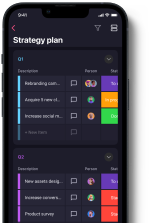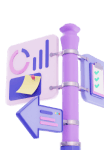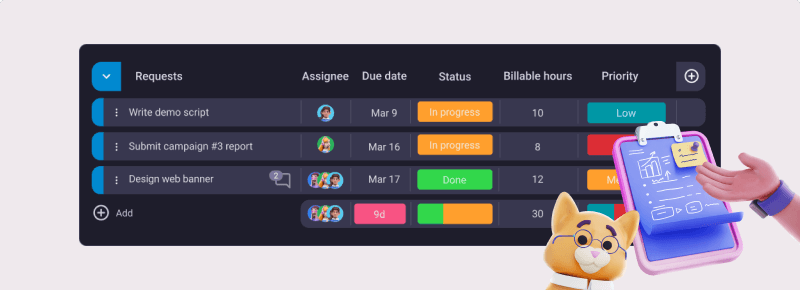If you think the biggest step to winning clients is to get them to buy your product/service, you couldn’t be more wrong. That is just where the story of onboarding and keeping your client begins.
But, if you don’t have an elaborate plan for the new client onboarding process, fear not — because we do.
In this article you will find all the steps you need to create a successful onboarding experience as well as tips from experts.
We will also provide you with a free new client onboarding checklist template to help you organize your onboarding processes.
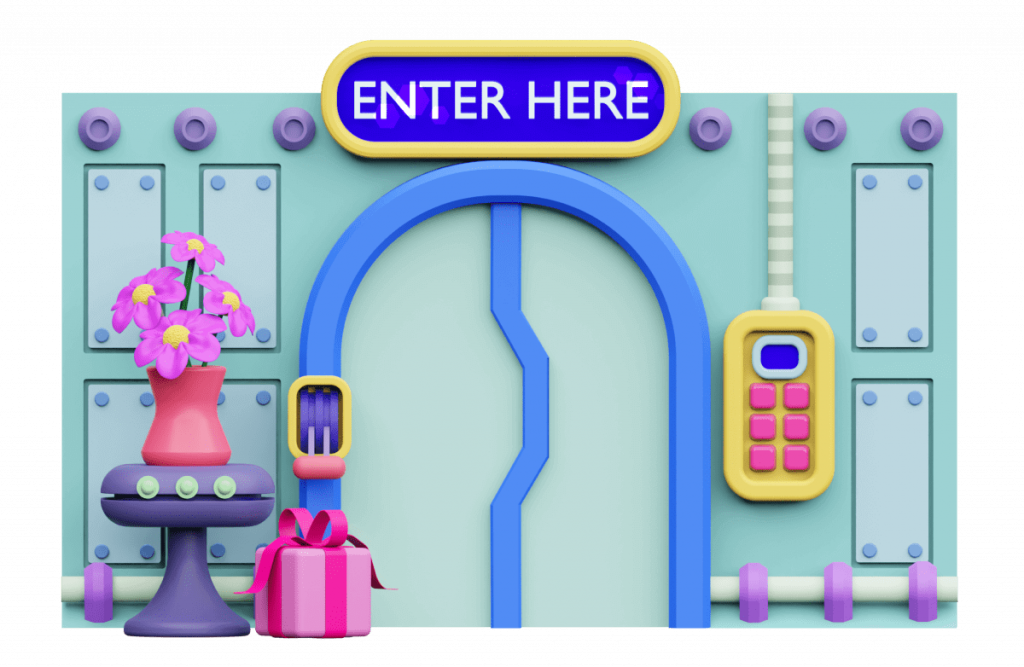
- Poor client onboarding is one of the biggest reasons for churn.
- The onboarding process should be personalized — personalized check-ins show you value your clients. It will make your new clients feel positive about choosing your company in the first place.
- The first step to client onboarding is sending a welcome email with the information how the onboarding process will proceed.
- Using a client onboarding checklist ensures no part of the onboarding process is overlooked.
Table of Contents
What is client onboarding?
Client onboarding is a process any new client goes through to learn how to use a new product or service efficiently.
The onboarding process is led by the company and serves to assess new clients’ needs. It includes steps such as:
- Welcoming the new client,
- Learning the client’s unique demands,
- Introducing the new client to a product/service, and
- Checking in on the client regularly.
It usually takes several months before the client is fully onboard. Of course, it all depends on the type of product/service.
7 steps to successfully onboard a new client
The client has signed the contract with your company.
Now, it’s up to you to make sure the client feels welcome and to provide all the necessary information to make the onboarding process comfortable for them.
If you’re wondering how to achieve this, we’ve curated a list of the 7 steps to help you prepare the best onboarding process for your new client:
- Send a welcome email,
- Conduct the first onboarding meeting,
- Present the client with your company’s product/service,
- Create and celebrate milestones,
- Check in with your client regularly,
- Pick a project management (PM) tool, and
- Follow the new client onboarding checklist.
Client onboarding step #1: Send a welcome email
You must show your client they are important to you. You can achieve this by sending a welcome email. These emails serve 2 purposes:
- They’re a token of appreciation, and
- They are informative.
So, apart from containing warm welcoming words, this email should indicate what the next steps of the onboarding process will be.
This way, the client will know exactly what to expect in the days to follow, and they’ll know how things are progressing.
The warm welcome will make the client feel more confident about choosing your company.
Tip: Make sure the email is not generic but a thoughtful message sent by a real person. Authentic communication will show your client you’re actually happy to have them on board.
New Client Onboarding Welcome Email Template
Take a look at this example of an authentic welcoming email:
Hi [name],
Thanks for signing up to [name], it’s great having you onboard! 🙂
I know you’re busy, so I’ll cut to the chase — our company’s goal is to deliver a product [specify] that you’ll be fully satisfied with.
Managing to make at least a tiny bit of difference using [product], we’ll consider the first step of our journey successful.
However, in order to tailor such a product, we need to hear your feedback. We’d be thankful if you could get back to us, and we are happy to arrange a meeting at your convenience. 🙂
Thanks again, and if you have any more questions, I’m here to help! 🙂
Looking forward to hearing from you!
Best,
[name]
The welcome email is a good time to schedule the next step in the onboarding process — the first onboarding meeting.
Client onboarding step #2: Conduct the first onboarding meeting
Arranging an online or in-person meeting is an important step in the onboarding process for several reasons:
- It sends a signal that you’re serious about the future collaboration with the client.
- It’s a great moment to introduce the client to your company’s goals and values.
- Taking time to speak to the client will show you value them as people and don’t merely see them as a source of profit.
- It gives the company a deeper insight into the clients’ needs, which makes you more likely to create useful products/services.
Make sure to stay focused on the client at this stage of the process. Also, try to encourage open communication by:
- Acknowledging the client’s fears and concerns, and
- Answering all their questions.
Keep in mind that different clients prefer different ways of communication. So, you should always have an alternative channel of communication prepared. For example, a client onboarding questionnaire is a quick and efficient way to collect huge amounts of data.
Tip: If you’re conducting an online meeting, pay attention to your background on the video call. New research into virtual first impressions by psychologists at Durham University showed that first impressions of trustworthiness and competence differ significantly based on the background you pick.
For example, a bookcase background is a great choice, whereas a home background ranks lowest when it comes to evoking the feelings of trustworthiness and competence.
After getting to know your client, it’s time to start talking about why they’re actually here — your product/service.
Client onboarding step #3: Present the client with your product/service
According to Wyzowl’s survey on customer onboarding, 86% of people say they are more likely to stay loyal to a business that invests in onboarding content that welcomes and educates them after they’ve bought a product/service.
The educational content should allow clients to learn at their own pace, as they’re able to review the provided materials at any time. Moreover, the content should be easy to digest and memorable.
Some of the most common ways to present a product or service include:
- Short video overviews (e.g. step-by-step walkthroughs),
- Short presentations (e.g. demonstrations),
- Written instructional materials (e.g. brochures), and
- Allowing the clients to test the product/service themselves (e.g. free trials).
Tip: Always make sure to highlight the ways in which your product/service will make a significant difference in performing everyday tasks.
All in all, a good presentation of a product/service should ultimately:
- Reduce churn,
- Increase the value of a product/service, and
- Create loyal clients.
Client onboarding step #4: Create and celebrate milestones
How can you conduct a successful client onboarding if you don’t know what you want to achieve in the first place?
This is why you need to define project milestones, or key events, in the onboarding process.
Although milestones should be unique to your product/service, the 3 more or less universal onboarding milestones are:
- The moment clients sign up for a product/service,
- The moment clients use the product/service for the first time, and
- The moment clients start using a product/service regularly.
Tip: Create smaller milestones. You’ll arrive at the final destination more easily by creating small stepping stones along the way.
Celebrating milestones is equally as important as creating them. Not only does paying attention to each successful milestone — no matter how small it is — give a motivational boost, but it’s also vital to the entire onboarding process.
Client onboarding step #5: Check in with new clients regularly
The onboarding process might be considered successful only when your clients are satisfied with your product/service.
And as Horst Schulze, CEO of the Capella Hotel group and Co-Founder of the Ritz-Carlton Hotel, said: “Unless you have 100% customer satisfaction, you must improve.”
But how can you know if your clients are satisfied? You need to check in with them regularly.
Here are some key points on when, how, and why you should conduct check-ins with new clients.
When to schedule check-ins with new clients
- In the beginning, follow-ups may be done on a more regular basis, e.g. every week.
- As the onboarding process progresses, follow-ups may be conducted every couple of months.
How to conduct check-ins with new clients
- Some clients will prefer live conversation rather than replying to emails or filling in questionnaires. Depending on the client, choose their preferred channel of communication. If not sure which one it is — simply ask them.
- Be prepared to do check-ins in various ways (e.g. live conversations, video call, email, questionnaire, etc.)
Why conduct check-ins with new clients
- You’ll collect important feedback on the product/service you offer.
- You’ll learn what can be altered and improved.
- You can address issues and maintain good customer service.
- Checking in shows you’re committed to providing clients with an excellent customer experience.
Personalized check-ins show you value your clients. Expressing interest in their onboarding progress will make your new clients feel positive about choosing your company in the first place.
💡 Plaky Pro Tip
Regular check-ins and excellent customer service lead to a higher customer satisfaction level. For more inspiration on how to maintain a great customer experience, check out this collection of famous quotes on the subject:
Client onboarding step #6: Pick the right tool
Onboarding one client is already a challenge, but if you have several clients to onboard, it can become quite overwhelming.
In that case, consider using a project management tool.
With sales project management software such as Plaky, you’ll stay on top of tasks throughout the entire onboarding process.
Client onboarding step #7: Follow the client onboarding checklist
If struggling with where to start, our advice is to follow a simple client onboarding checklist and use it as a roadmap.
Client onboarding checklist (+ template)
Checklists are an excellent organizing method that ensures you don’t miss any steps along the way.
We have created a new client onboarding checklist template you can use to ensure that no element of the process is overlooked.
It consists of 13 tasks:
- Send a welcome email,
- Do background research on the client,
- Schedule the first onboarding meeting,
- Collect relevant documentation (e.g. contracts),
- Collect client’s personal information (e.g. send out a questionnaire),
- Present the product/service (tutorial, meeting, demonstration etc.),
- Create short-term milestones,
- Create long-term milestones,
- Celebrate milestones,
- Schedule a weekly check-in with the client,
- Schedule a monthly check-in with the client,
- Schedule a 6-month check-in with the client, and
- Pick a project management (PM) tool for managing the onboarding process.
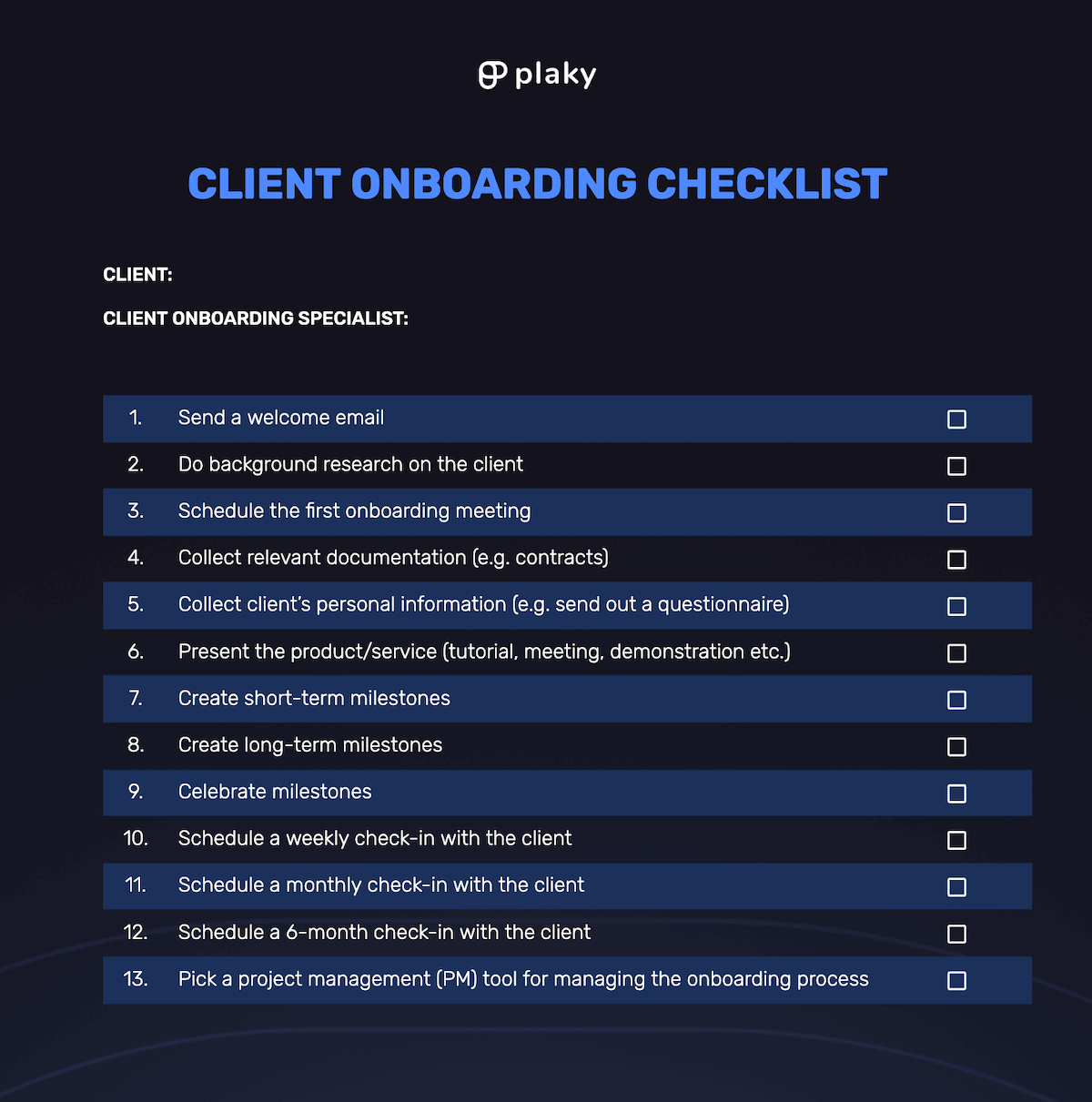
🔽 New client onboarding checklist template
Of course, you can always tailor the checklist to your onboarding process — the same way you tailor the onboarding process to your new client.
Client onboarding practices you should follow
We have spoken to experts and asked them to share what client onboarding practice they feel is most important.
Here’s what they singled out:
- Practice #1: Keep the communication personal,
- Practice #2: Understand why they chose you,
- Practice #3: Do background research, and
- Practice #4: Understand the clients.
Practice #1: Keep the communication personal
Although it may be easier to just automate the onboarding process, making an effort to personalize your onboarding truly pays off.
We spoke to Sarah Jeffries, the Managing Director of First Aid Course Leicester, who provided insight into their client onboarding process:

“In our business, the most important aspect of client onboarding is personalized communication. We understand the importance of promptly addressing our clients’ specific needs and concerns. To ensure they have a clear understanding of our first aid courses, we provide detailed information including course outlines, schedules, and any prerequisites.”
Practice #2: Understand why they chose you
When we asked Annie Raygoza, Director of Client Services at Clear Digital, what she pays special attention to in new client onboarding process, she emphasized that it’s paramount to understand why the clients chose their services:

“Understanding WHY they chose us. What did we accomplish to win this account? Honing in on these areas while speaking to the client’s pain points is integral to this process.”
Practice #3: Do background research
Raygoza also explained how important it is to prepare for client onboarding and to research the client:

“Doing the necessary groundwork and background on the client allows the team to really understand the client’s needs. Avoid putting something together that’s generic. By customizing a kick-off deck and meeting with the client, you’re letting them know that you’ve done the appropriate amount of research, and you’re coming prepared to discuss their specific needs for the project/request.”
Practice #4: Understand the client’s expertise
Aside from doing general background research, you should also find out how experienced the client is when it comes to the type of product/service you provide.
One of the best practices of client onboarding according to Amanda Stephens, Vice President of Operations at seoplus+, a full-service digital marketing agency, is understanding how much your clients know about your field of business:

“Understand your client’s level of understanding. For a client without much exposure to your field, using jargon and taking things for granted in the onboarding process can be alienating and intimidating. But for a client with experience in the field, being really slow and deliberate might come across as condescending. So we make sure to really understand the client and where they’re coming from to make for a successful & supportive onboarding process.”
Why is client onboarding important?
Client onboarding is important because it’s an opportunity for you to show your client how to best utilize your product/service and get to know the client at the same time. This way, you can provide better service and ensure that they are satisfied with your company.
According to UserGuiding’s report, 97% of companies state that good user onboarding is necessary for effective product growth.
Proper onboarding will skyrocket clients’ satisfaction levels. The benefits of this are twofold:
- Establishing trust between the company and new clients, and
- Enhancing opportunities for continued cooperation between the company and new clients.
As you can see — well-executed onboarding is a classic win-win situation.
Streamline client onboarding with Plaky
Plaky offers a pre-made client onboarding template that helps you easily organize the onboarding process and saves you some valuable time and energy by allowing you to have all the important information in one place.
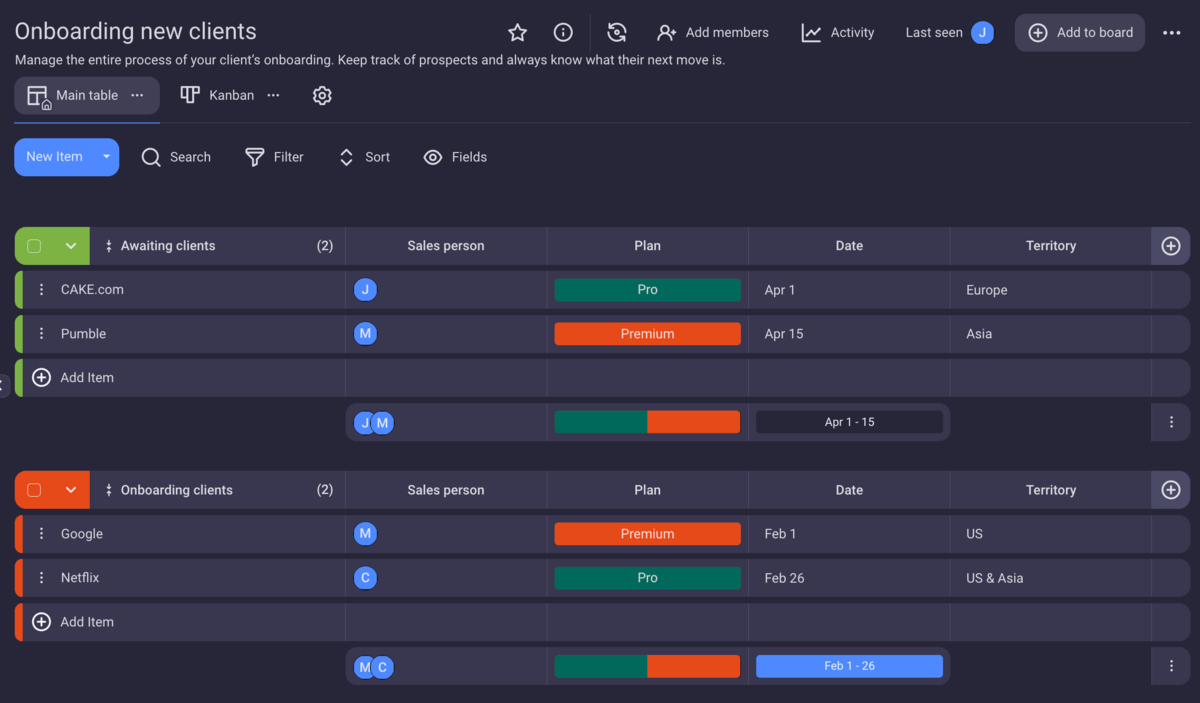
You can organize tasks into Groups according to any criteria that suits you and then give each group a name. For example, in this template we have grouped tasks into:
- Awaiting Clients,
- Onboarding Clients, and
- Paying Clients.
With the Person field, you’ll keep track of all the team members assigned to different onboarding tasks. You can even customize this field if needed. As you can see in the screenshot above, we changed the name of this field to Sales Person so that it better fits the needs of our team.
With the Status field, you can manage the onboarding tasks by assigning different statuses. In the screenshot, the name of the status field was changed into Plan. This way, you’ll never lose track of which plan you’re presenting to which client, e.g. Pro, Premium, or any other.
With the Date field, you won’t have to worry about due dates or any other time-related issues, such as:
- Whether you’ve sent the welcoming email to your new client,
- Whether the first onboarding session has been scheduled, or
- What time your next check-in is scheduled.
With the Text field, you’re free to add personalized client information or any other information relevant to the onboarding process.
This template is fully customizable, so you can add another field if you need to, such as Tag field, or Numbers field. On the other hand, if you don’t need some of the existing fields, you can just delete them.
Of course, you can always create a new board from scratch and design it for your client onboarding process.



